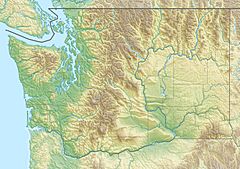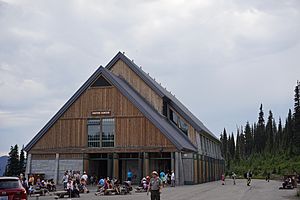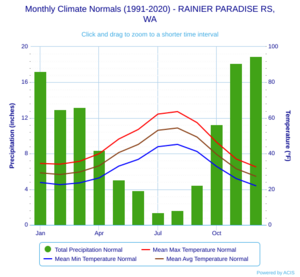Paradise, Washington facts for kids
Quick facts for kids
Paradise
|
|
|---|---|
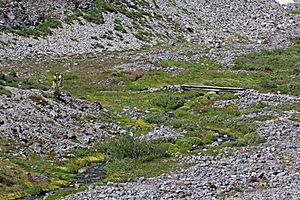
Hikers and wildflowers along the Paradise River near its source
|
|
| Country | United States |
| State | Washington |
| County | Pierce |
| Elevation | 5,400 ft (1,600 m) |
| Time zone | UTC-8 (Pacific (PST)) |
| • Summer (DST) | UTC-7 (PDT) |
Paradise is a beautiful area high up on Mount Rainier in Washington, United States. It sits about 5,400 feet (1,646 meters) above sea level. This special spot is part of Mount Rainier National Park.
Paradise is located on the south side of Mount Rainier. It is southeast of Seattle. The area crosses the border of Pierce and Lewis counties. It includes the lovely Paradise Valley and the Paradise Glacier. This glacier is where the Paradise River begins its journey.
A woman named Virinda Longmire gave Paradise its name in the summer of 1885. She was amazed by the many colorful wildflowers in the alpine meadows. She thought it looked like paradise! From this area, you can also see amazing views of Mount Rainier and the Tatoosh Range.
Contents
Welcome to Paradise!
Paradise is the most popular place for people to visit in Mount Rainier National Park. In 2000, more than 1.3 million people visited the park. A big 62% of them came to Paradise!
Exploring Paradise: A Popular Spot
The road from the Nisqually entrance of the National Park to Paradise is called State Route 706. It is one of the few roads in the park that stays open for cars in the winter. The very first road to Paradise was finished in 1911.
A Look Back: How Paradise Grew
In the late 1800s, many visitors came to Longmire Springs. They wanted to see Mount Rainier up close. James Longmire's son, Elcaine, made a simple path to Paradise Park around 1885. Later, in 1892, Elcaine's son, Leonard, and a worker named Henry Carter built a better path. This path followed the Paradise River. For many years, the Longmire family charged visitors 50 cents to use this improved route.
Famous Buildings in Paradise
Paradise is home to some important buildings. The historic Paradise Inn was built in 1916. The Paradise Guide House was built in 1920. The Henry M. Jackson Visitor Center was first built in 1966. It was replaced with a new building in 2008. The old visitor center was taken down in 2009. The Paradise Inn is so special that it is listed on the National Register of Historic Places. The main part of Paradise is even called the Paradise Historic District.
In 1931, a golf course was built in Paradise. Five years later, a rope tow was added for alpine skiing. These were built for guests staying at the inn. From 1942 to 1943, the U.S. Army used the inn. Soldiers from the 87th Mountain Infantry trained there for winter mountain conditions during World War II.
The National Park Service spent $30 million to fix up the Paradise Inn. They made it strong enough to handle a big earthquake. They also replaced the old "flying saucer-shaped" visitor center. The new visitor center looks more like the historic lodge. Both the inn and the new visitor center opened in 2008.
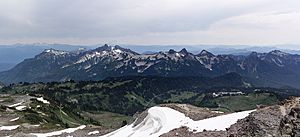
Weather Wonders: Snow in Paradise
The National Park Service says Paradise is one of the snowiest places on Earth. They measure snowfall there regularly. In the winter of 1971–1972, a world record was set. A huge 1,122 inches (28.5 meters) of snow fell!
The least amount of snow in one year was 266 inches (6.7 meters) in 2014–2015. The deepest snow on the ground was 367 inches (9.3 meters). This happened on March 9–10, 1956. No snow was measured from 1943 to 1946. This was because the road to Paradise was closed during World War II.
Even with all that snow, no month in Paradise has average high temperatures below freezing. Paradise has a type of weather called a subpolar oceanic climate. You could also call it a subarctic or subalpine climate.
| Climate data for Paradise Ranger Station, 1991–2020 normals, extremes 1916–present | |||||||||||||
|---|---|---|---|---|---|---|---|---|---|---|---|---|---|
| Month | Jan | Feb | Mar | Apr | May | Jun | Jul | Aug | Sep | Oct | Nov | Dec | Year |
| Record high °F (°C) | 65 (18) |
63 (17) |
70 (21) |
78 (26) |
83 (28) |
90 (32) |
92 (33) |
92 (33) |
89 (32) |
88 (31) |
78 (26) |
63 (17) |
92 (33) |
| Mean maximum °F (°C) | 48.9 (9.4) |
49.9 (9.9) |
52.2 (11.2) |
59.5 (15.3) |
68.4 (20.2) |
72.1 (22.3) |
78.6 (25.9) |
78.9 (26.1) |
75.6 (24.2) |
65.6 (18.7) |
54.4 (12.4) |
48.0 (8.9) |
81.4 (27.4) |
| Mean daily maximum °F (°C) | 34.5 (1.4) |
34.1 (1.2) |
35.7 (2.1) |
40.0 (4.4) |
48.2 (9.0) |
53.6 (12.0) |
62.2 (16.8) |
63.6 (17.6) |
57.4 (14.1) |
46.4 (8.0) |
37.0 (2.8) |
32.6 (0.3) |
45.4 (7.4) |
| Daily mean °F (°C) | 29.2 (−1.6) |
28.3 (−2.1) |
29.7 (−1.3) |
33.2 (0.7) |
40.6 (4.8) |
45.2 (7.3) |
53.1 (11.7) |
54.4 (12.4) |
49.3 (9.6) |
39.6 (4.2) |
31.5 (−0.3) |
27.3 (−2.6) |
38.5 (3.6) |
| Mean daily minimum °F (°C) | 23.8 (−4.6) |
22.6 (−5.2) |
23.6 (−4.7) |
26.4 (−3.1) |
33.0 (0.6) |
36.8 (2.7) |
43.9 (6.6) |
45.2 (7.3) |
41.2 (5.1) |
32.8 (0.4) |
26.0 (−3.3) |
22.0 (−5.6) |
31.4 (−0.3) |
| Mean minimum °F (°C) | 11.8 (−11.2) |
9.6 (−12.4) |
12.3 (−10.9) |
16.0 (−8.9) |
21.2 (−6.0) |
26.3 (−3.2) |
32.1 (0.1) |
33.3 (0.7) |
29.9 (−1.2) |
19.6 (−6.9) |
13.6 (−10.2) |
9.4 (−12.6) |
3.4 (−15.9) |
| Record low °F (°C) | −13 (−25) |
−18 (−28) |
−2 (−19) |
2 (−17) |
10 (−12) |
13 (−11) |
15 (−9) |
22 (−6) |
18 (−8) |
2 (−17) |
−11 (−24) |
−20 (−29) |
−20 (−29) |
| Average precipitation inches (mm) | 17.22 (437) |
12.93 (328) |
13.21 (336) |
8.35 (212) |
5.08 (129) |
3.84 (98) |
1.41 (36) |
1.64 (42) |
4.43 (113) |
11.25 (286) |
18.16 (461) |
18.92 (481) |
116.44 (2,958) |
| Average snowfall inches (cm) | 118.7 (301) |
91.6 (233) |
90.6 (230) |
67.5 (171) |
26.1 (66) |
5.6 (14) |
0.3 (0.76) |
0.0 (0.0) |
1.4 (3.6) |
24.1 (61) |
120.9 (307) |
124.0 (315) |
670.8 (1,704) |
| Average extreme snow depth inches (cm) | 135.2 (343) |
159.7 (406) |
184.9 (470) |
187.4 (476) |
164.6 (418) |
113.2 (288) |
44.8 (114) |
5.2 (13) |
0.8 (2.0) |
12.0 (30) |
48.4 (123) |
99.0 (251) |
195.2 (496) |
| Average precipitation days (≥ 0.01 in) | 21.1 | 17.8 | 21.5 | 18.8 | 15.4 | 12.8 | 7.3 | 6.6 | 9.6 | 15.0 | 21.7 | 21.1 | 188.7 |
| Average snowy days (≥ 0.1 in) | 18.5 | 15.9 | 19.5 | 14.4 | 7.9 | 2.5 | 0.2 | 0.0 | 0.7 | 6.2 | 16.6 | 19.0 | 121.4 |
| Source 1: National Weather Service | |||||||||||||
| Source 2: NOAA (average snowfall/snowy days and precip days 1981–2010) | |||||||||||||
See also
 In Spanish: Paradise (Washington) para niños
In Spanish: Paradise (Washington) para niños



